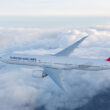Boom Supersonic, the company building the world’s fastest airliner, is celebrating the completion of construction of its Overture superfactory. The facility, located at the Piedmont Triad International Airport (GSO) in Greensboro, North Carolina, is the first supersonic airliner factory in the United States. The factory will be the assembly point for the Overture, Boom’s supersonic airliner which is expected to be capable of flying twice as fast as traditional commercial aircraft using up to 100% sustainable aviation fuel (SAF).

The 179,000 square foot facility was completed in 17 months and the first assembly line is expected to produce 33 Overture aircraft per year. Boom has plans to open an additional assembly line in the future which is expected to double manufacturing capacity.
Blake Scholl, founder and CEO of Boom Supersonic, had this to say regarding the opening of the facility:
“Construction of the Overture Superfactory represents a major milestone toward ensuring the United States’ continued leadership in aerospace manufacturing. Supersonic flight will transform air travel, and Overture provides a much-needed innovative alternative for airlines across the globe.”
Blake Scholl, Boom CEO
Boom notes in the press release that, with the facility now complete, they will begin operationalizing the production floor. The company will begin procuring and installing tooling into the Superfactory, starting with an advanced test cell unit. This will be the first major piece of equipment to be installed and will be used to develop manufacturing processes, optimize the flow of the assembly line, and prepare staff for Overture production.
The state of North Carolina projects that the superfactory will grow the state’s economy by at least $32.3 billion over 20 years, with the Superfactory directly adding more than 2,400 jobs. North Carolina Senate President Pro Tempore Phil Berger had this to say about the new facility:
“The Piedmont Triad region is an economic powerhouse, helping solidify North Carolina’s place as the top state for business. Boom’s Overture Superfactory, which will produce a paradigm-changing airliner, showcases the new and innovative projects that are bringing jobs and investment here.”
Phil Berger, North Carolina Senate President Pro Tempore

About the Boom Overture
The Overture is projected to be the world’s fastest airliner, flying at twice the speed of today’s current commercial jets. The plane is being optimized to run on up to 100% sustainable aviation fuel (SAF). Currently, the company’s order book stands at 130 aircraft, including orders and pre-orders from American Airlines, United Airlines, and Japan Airlines.

Scott Kirby, United’s CEO, said this about the Overture aircraft:
“United continues on its trajectory to build a more innovative, sustainable airline and today’s advancements in technology are making it more viable for that to include supersonic planes. Boom’s vision for the future of commercial aviation, combined with the industry’s most robust route network in the world, will give business and leisure travelers access to a stellar flight experience. Our mission has always been about connecting people and now working with Boom, we’ll be able to do that on an even greater scale.”
Scott Kirby, United CEO
Boom is working with Northrop Grumman for government and defense applications of Overture. Suppliers and partners collaborating with Boom on the Overture program include Aernnova, Aciturri, Collins Aerospace, Eaton, Honeywell, Latecoere, Leonardo, Safran Landing Systems, and the United States Air Force.
The Boom XB-1, the supersonic demonstrator aircraft that is preceding Overture, made its first flight this year. Boom initially projected that the Overture would carry passengers in 2029, though that timeline will likely shift as the company has had issues finding an engine supplier and even overhauled the design of the aircraft in recent years
Summary
The opening of the Boom Superfactory brings production of the Overture one step closer to reality. The company operated the first flight of it’s supersonic demonstrator earlier this year and is in the process of building out the infrastructure to produce the plane. While the company still intends to begin transporting passengers in 2029, the real timeline is likely much longer.
It will be interesting to watch and see how the construction timeline of the jet passes and whether we see supersonic aircraft flying passengers in the next 10 years. American, United, and Japan Airlines have all placed orders for the plane so, just maybe, we’ll all have the opportunity to fly supersonic soon.






